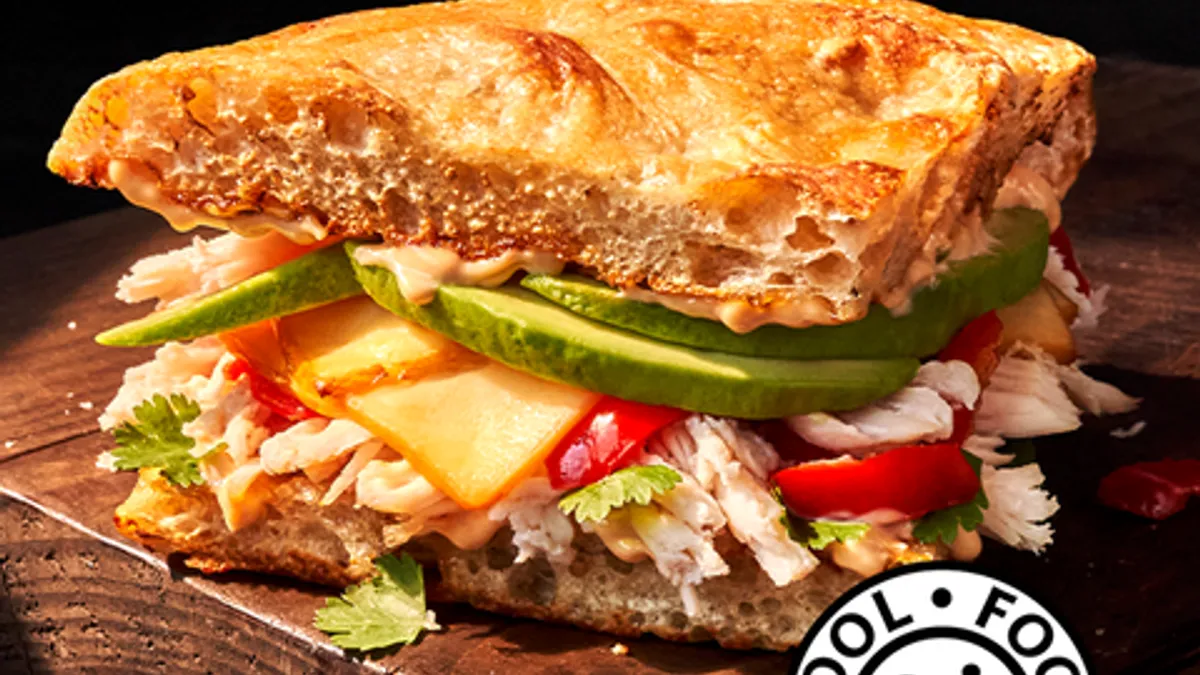Dive Brief:
- Panera has announced its intention to remove more carbon from the atmosphere than it emits by 2050, alongside several intermediate goals for 2025, in a press release Wednesday.
- Panera plans to improve the sustainability of its menu items, implement 100% recyclable, reusable and compostable packaging, and increase its purchases of renewable energy in the next four years. Company-owned stores will use 50% renewable energy by 2025.
- In 2020, the company began to offer “Cool Foods” on its menu, which are offerings that meet a World Resource Initiative standard for climate friendly foods. Panera said 60% of its entrees will be considered Cool Foods by 2025.
Dive Insight:
The company said consumers have responded well to ongoing sustainability efforts. Sara Burnett, vice president of food beliefs and sustainability at Panera, said data from the company’s loyalty program showed consumers welcomed the Cool Foods Meals.
“They’re purchasing and repurchasing those items,” Burnett said. “We're just seeing a more informed, engaged consumer who's starting to vote with their wallet.”
About half of Panera entrees met the Cool Food Meals standard when Panera first began labeling them in October 2020. By 2025, the company said at least 60% of entrees will be climate friendly. Burnett emphasized that many of Panera’s most popular dishes already count as Cool Food Meals.
“The things that people crave and come to Panera for are Cool Food meals,” Burnett said. “We already have a great pantry, that's a balance of a lot of fresh vegetables and balanced with kind of lower carbon proteins,” Burnett said. The broccoli cheddar soup, for example, is one of its Cool Food Meals and also the company's top selling soup.
Burnett said its 2025 sustainability goals would improve on practices the chain already uses, including reusable packaging and utensils.
“Panera is one of the few concepts today that still uses real silverware and plates in cafes when you’re dining in. We’re going to continue to do that,” Burnett said. To-go packaging elements will resemble the compostable grain bowls the company debuted last summer. Panera also switched from serving hot sandwiches in to-go boxes to serving them in compostable thermal wraps, Burnett said.
The company also plans to buy 50% of the electricity for its corporate stores from renewable sources by 2025.
According to the press release, Panera emits the equivalent of about 2.4 million metric tons of carbon dioxide every year. Panera claims to be the first fast-casual chain to set a goal of being climate positive by mid-century, according to the press release. But that promise relies on unproven technologies.
The path to climate positivity, Burnett said, includes carbon capture and sequestration, a technology that has yet to be deployed at scale.
“There are not broad-based sequestration technologies available,” Burnett said.
Burnett added that while Panera is working with its supply chain partners to promote sustainable solutions, the impact any one company has is fairly limited. Most countries and major firms that have announced climate goals are not meeting them, or are falling short of the reductions necessary to keep warming below the 1.5 degree Celsius target set by the Paris Agreement, Burnett said.
“It really is actually about widespread change across absolutely all commerce and all consumer behavior,” Burnett said.
Perhaps in tension with its climate goals, Panera recently announced it will target suburban markets with stores featuring dual drive-thru technology. Suburbs tend to emit more carbon per capita than cities, and passenger vehicles make up about 15% of U.S. carbon emissions.












